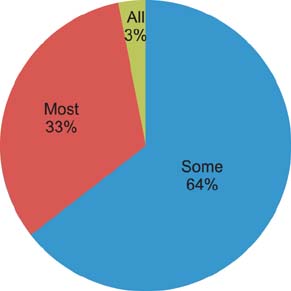Clin Orthop Surg.
2014 Dec;6(4):462-467. 10.4055/cios.2014.6.4.462.
Robotic and Navigation Systems in Orthopaedic Surgery: How Much Do Our Patients Understand?
- Affiliations
-
- 1Department of Trauma and Orthopaedics, University College London Hospital, London, UK. shivan.jassim@doctors.org.uk
- KMID: 1794736
- DOI: http://doi.org/10.4055/cios.2014.6.4.462
Abstract
- BACKGROUND
Technology in orthopaedic surgery has become more widespread in the past 20 years, with emerging evidence of its benefits in arthroplasty. Although patients are aware of benefits of conventional joint replacement, little is known on patients' knowledge of the prevalence, benefits or drawbacks of surgery involving navigation or robotic systems.
METHODS
In an outpatient arthroplasty clinic, 100 consecutive patients were approached and given questionnaires to assess their knowledge of navigation and robotics in orthopaedic surgery. Participation in the survey was voluntary.
RESULTS
Ninety-eight patients volunteered to participate in the survey, mean age 56.2 years (range, 19 to 88 years; 52 female, 46 male). Forty percent of patients thought more than 30% of National Health Service (NHS) orthopaedic operations involved navigation or robotics; 80% believed this was the same level or less than the private sector. One-third believed most of an operation could be performed independently by a robotic/navigation system. Amongst perceived benefits of navigation/robotic surgery was more accurate surgery (47%), quicker surgery (50%), and making the surgeon's job easier (52%). Sixty-nine percent believed navigation/robotics was more expensive and 20% believed it held no benefit against conventional surgery, with only 9% believing it led to longer surgery. Almost 50% would not mind at least some of their operation being performed with use of robotics/navigation.
CONCLUSIONS
Although few patients were familiar with this new technology, there appeared to be a strong consensus it was quicker and more accurate than conventional surgery. Many patients appear to believe navigation and robotics in orthopaedic surgery is largely the preserve of the private sector. This study demonstrates public knowledge of such new technologies is limited and a need to inform patients of the relative merits and drawbacks of such surgery prior to their more widespread implementation.
Keyword
MeSH Terms
Figure
Reference
-
1. National Joint Registry [Internet]. Hemel Hempstead: National Joint Registry;c2008-2014. cited 2014 Aug 30. Available from: http://www.njrcentre.org.uk.2. Lang JE, Mannava S, Floyd AJ, et al. Robotic systems in orthopaedic surgery. J Bone Joint Surg Br. 2011; 93(10):1296–1299.3. Lavernia CJ, Contreras JS, Parvizi J, Sharkey PF, Barrack R, Rossi MD. Do patient expectations about arthroplasty at initial presentation for hip or knee pain differ by sex and ethnicity? Clin Orthop Relat Res. 2012; 470(10):2843–2853.4. Hamilton DF, Lane JV, Gaston P, et al. What determines patient satisfaction with surgery? A prospective cohort study of 4709 patients following total joint replacement. BMJ Open. 2013; 3(4):e002525.5. Cobb J, Henckel J, Gomes P, et al. Hands-on robotic unicompartmental knee replacement: a prospective, randomised controlled study of the acrobot system. J Bone Joint Surg Br. 2006; 88(2):188–197.6. Jolles BM, Genoud P, Hoffmeyer P. Computer-assisted cup placement techniques in total hip arthroplasty improve accuracy of placement. Clin Orthop Relat Res. 2004; (426):174–179.7. Gandhi R, Marchie A, Farrokhyar F, Mahomed N. Computer navigation in total hip replacement: a meta-analysis. Int Orthop. 2009; 33(3):593–597.8. Bozic KJ, Smith AR, Hariri S, et al. The 2007 ABJS Marshall Urist Award: the impact of direct-to-consumer advertising in orthopaedics. Clin Orthop Relat Res. 2007; 458:202–219.
- Full Text Links
- Actions
-
Cited
- CITED
-
- Close
- Share
- Similar articles
-
- Spinal surgery using image-guided navigation systems: a technical note
- Robotic Spine Surgery and Augmented Reality Systems: A State of the Art
- Intraoperative Navigation in Reverse Shoulder Arthroplasty: Advantages and Future Prospects
- Computer-Assisted Orthopaedic Surgery and Robotic Surgery in Total Hip Arthroplasty
- Hybrid Endoscopic Thoracic Discectomy Using Robotic Arm and Navigation for Highly Migrated Calcified Disc Herniation







